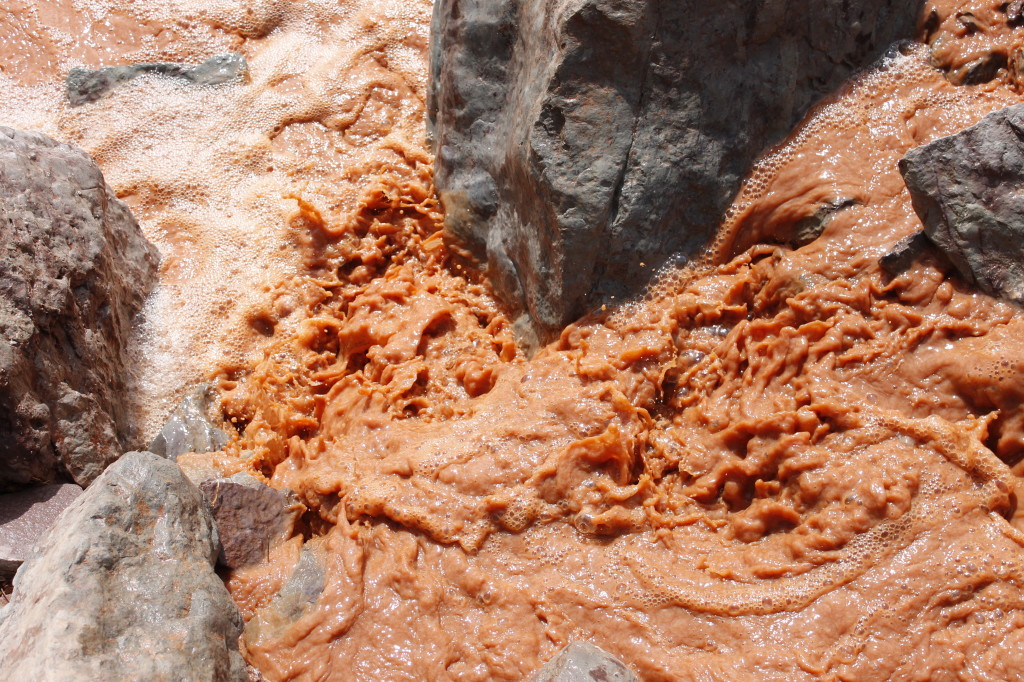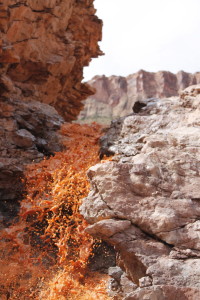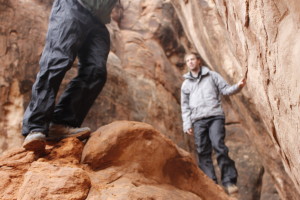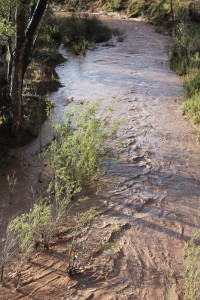What do you need to know before you and your friends go into the mountains?
How to tie a tourniquet on a bleeding arm. How to sterilize wounds with bonded liquor. How to rub cuts full of dirt, take it like a man and wear the scars with pride.
At least Hollywood would have you think so.
This March, I finally decided to learn the real stuff and take a Wilderness First Responder course (a.ka. the WFR or Woofer.)
Maybe I wouldn’t have rubbed anyone’s wounds full of dirt before this class, but I also wouldn’t have been able to go beyond basic care in a backcountry medical situation in the backcountry. I would have screwed a lot of things up.
I’ll blame a misplaced sense of rugged individualism for not getting educated sooner. The only classroom you need is out there! I’d think. Spend time in it and you will learn.
Yes, I have learned a lot out there, but it’s not always a nice classroom. It’s a place where wrong decisions deal higher consequences than a flunked exam; sometimes they lead to dead bodies and lifelong injuries. I’m fortunate not to have faced such a test in my time outdoors, but the odds increase every trip. It was time to study up and get prepared.
The classroom at Fort Lewis College in Durango, Colo. looked a bit more forgiving than the flank of a mountain peak, or thrashing Class IV rapid. Over nine straight days of Wilderness First Responder instruction, this would be the place where I would get the facts about how to identify wilderness maladies and learn how to treat them. The course wouldn’t just be about copying notes off a whiteboard though. We were outside several times during the day, practicing medical scenarios, practicing new skills on other students with pretend vitals.
An abbreviated version of one of these might look something like this:
A fellow trainee and I walk outside to find a guy sprawled out at the base of the tree. He’s just taken a massive fall on a ski-slope in our scenario.
“OK. Scene safety. Is there anything else going on here, risk of avalanche?”
“Don’t think so.”
“What happened to him?”
“Looks like he’s taken a big-ass fall.’
“Let’s get our gloves on.”
“Anybody else out here?”
We look around, ignoring the other trios of students going through the same exercise.
“Think he’s dead?”
“Nope, he’s moving. Let’s go see what’s up.”
As soon as we get the patient’s permission to help, one of us grabs his head so he can’t move it around and exacerbate a possible spinal injury.
Then we check his airway, breathing and circulation, looking for blood underneath his clothes or on our gloves as we sweep his body.
Uh oh. The patient is complaining of chest pain. It’s the crushing kind that indicates a possible heart attack. There are plenty of false flags for heart attacks, including heartburn. Right now, I’m thinking the heart attack is more likely than a pulmonary embolism, which often exhibits stabbing pain or a broken rib that presents with point tenderness and painful breathing.
My mind is racing. How do we help this guy without killing him? Can we fix him before he dies in front of us?
The head to-toe body exam can wait, I decide. Let’s get right into vitals and his medical history.
Sure enough, vitals show elevated heart-rate (the patient tells me to add 30 beats to the measurement I get from his wrist. Systolic blood pressure is above 100 millimeters of mercury, so an appropriate dose of nitroglycerine might just be the ticket. If he has any.
I rattle down the questions about symptoms allergies and meds. History of heart problems, and … Yes! He has nitroglycerine. Just as important, the doc has said he should take it when he has chest pain.
I’ve got to watch myself though. A Wilderness First Responder is authorized to administer over-the-counter drugs as-needed. Nitroglycerine is definitely not over-the counter.
But if the patient takes the medication of his own free will, I should be able to defend myself in court if it all goes wrong.
I restrain myself even as the chest pain persists and I worry about the damage that the heart attack is doing.
“Sir, have you taken any recreational drugs today? We’re not the cops, but we need to know so we can give you the best treatment? No drugs? O.K have you had any alcohol?
Other pertinent medical information would include how much water and food the patient has had today; how much has he peed and what color, when and what his last bowel movement was like (“it’s kind of a personal question, BUT…”) Then he has to re-describe the events leading up to the crash.
The chest pain came before the crash, he tells us, an important detail.
I look at my training partner. Yeah, we should have him take the nitro before the heart attack kills him.
The patient pops his nitroglycerine and now it’s time to check the vitals again to see what the medication did to him.
Level of Responsiveness: “OK, so I’ve already asked you this before, but can you tell us your name?”
No responsiveness.
The patient isn’t breathing. No pulse either.
“Shit!”
My partner starts fake CPR, pumping his hands up and down a couple of inches above the patient’s chest. (real chest compressions can break ribs) and delivering imaginary rescue breaths.
After a couple rounds, our patient comes back to life, but he’s not a 67-year-old man having a bad day on the slopes anymore. He’s died and reincarnated back into a WFR student in his early 20s.
The student grins.
“You forgot to ask me if I was on any ED medication.”
My partner and I groan. Of course. The class had just covered how vasodilators like Viagra lower blood pressure and can take it for a life-threatening drop when comboed with nitro, another vasodilator.
It’s one to watch out for, because the same older folks that are more likely to get a heart attack are also more likely to be taking Viagra, Levitra or other erectile dysfunction drugs. Making matters trickier, a patient may not be forthcoming about his (or her!) little blue friend. It’s something that is definitely worth pushing the patient about in a heart-attack case, whether or not the patient wants to talk about it.
And what about aspirin? That was on me too. Throughout the scenario, I thought nitroglycerin would be the knight in shining armor that would save the day. I’d gotten tunnel vision that stopped me from thinking about the benefit that an adult aspirin pill might have had for the patient.
Looking at my notes, I see a garbled mess of med stats and symptoms, the product of trying to do everything super-fast, and the fact that I am still getting used to processing the oodles of data we get from patients. We have to put it all into a standardized report for the ambulance and hospital people — then maybe the lawyers.
Randy, one of our two instructors welcomed us on our first day of class by saying that we were about to journey through the scope of Western medicine in nine days.
Exaggeration or no, my pen flew across the notebook with each new topic: head injuries, splinting broken bones, using a herring-bone technique to restore a dislocated shoulder, putting a femur fracture in traction using what you’ve got in the backcountry, appendicitis, how to evac someone in a litter, conduct a search party, treat vaginitis, how to deal with it when a guy’s junk gets twisted into a testicular torsion, when to thaw frostbite in warm water, when you definitely shouldn’t thaw frostbite in warm water, diabetes, seizures, making an informed decision about whether it’s safe to rule out spinal injury in a patient, knowing when it’s Acute Mountain Sickness or High Altitude Cerebral Edema, knowing when to evac and when to deal with it on your own, dealing with it when a chest puncture creates a collapsed lung. Most important of all was learning prevention, namely having the smarts to prevent that bad shit from happening in the first place.
We would have WFR dreams, Randy told us. It was true. I’d wake up thinking about putting antibiotic ointment and gauze over a burn wound or doing a patient assessment in some dark corner of the woods.
I woke at around six in the morning most days in a tarp-tent that I’d set up in a campground 15 miles out of town. I’d take time to review notes and (maybe) wash myself over the bathroom sink before learning commenced. Sometimes, I’d mumble my way through an imaginary patient assessment on the drive.
After class, I’d finish a run before sunset and then park my car in a supermarket parking lot, feverishly reading chapter after chapter from the First Responder textbook and trying to absorb the information.
My biggest challenge was keeping my thinking straight and organized when presented with situations like the heart attack on the slopes. More than once, I charged ahead with what I thought was the proper course of action but got flummoxed when I overlooked a crucial detail. Whole chapters of data would evaporate from my head as I tried to understand why this patient was unconscious, or figure out how to treat that patient who was going into shock.
I managed to amass a small virtual body count by the end of the course.
The truth was, that this stuff didn’t come easy. Nor did I feel like I was at the top of the class. I envied the students who came up with fast and effective solutions, flowing effortlessly from one step to the next, clicking onto the pattern while I was still shuffling puzzle pieces around on the table.
Was my earlier reluctance to take the course really a fear that the new information would make my head explode?
The challenge of grabbing all the relevant information and shaping it into a coherent medical report/plan of action, reminded me of some of the big stories I’ve worked on as a reporter.
To do either job right, it is key to know how to ask the right questions and shape them into a coherent narrative, be that a 1,000 word story going in right before deadline or a plan for how to get someone out of the woods alive. Both rescuers and storytellers have to sift through the facts, thin out irrelevant or misleading ones and then do their jobs based on the best information.
There’s something else about putting things down in narrative. Explicating ideas clearly is the only way to see if they make any sense.
I reflected on my old idea that I could know what needed to be done based on experience as I drove back to my campsite at night. Thank God they don’t hand out medical degrees that way.
I still love the populism of the outdoors. Most mountains don’t have admission fees; you don’t a special permit to hike the Appalachian Trail or go bushwhacking in a National Forest. I worried that taking a wilderness course might be admitting that I thought I needed elite knowledge in order to keep doing what I’ve been doing.
Well, no. I could probably keep right on doing what I love outside WFR certified or not. Having the background in the basics of medical emergencies is definitely a tool though, and a potential saving grace in an emergency.
The other side of getting a Wilderness First Responder is that now that I have it, I feel like I can tackle more ambitious projects in the wilderness than I did before. With this, and proper planning, I would feel confident about setting out on a multi-week trip into the backcountry. I like knowing that I can rely more on my own resources now and that I’m that much less likely to need outside help to get through a situation.
Even in situations where I would need help from outside, I’d be far more helpful to rescuers as someone waiting with a set of vital signs or the knowledge of how to find a proper helicopter landing spot.
Respecting the outdoors includes acknowledging its power to punish ignorance. I realized that pursuing more knowledge — whether in straight experience, or in classes — is a way to show respect for this.
Now I see the course as a jumping-off point. I passed the test on paper; I made my way through the scenarios; if there I face the real test one of these days, I’ll know that I’ve done some homework.
A short while after I passed the course, a friend of mine slammed his finger badly. His face went pale white and he had a steady bleed.
“Yes!” I thought. “Here’s a chance to use the med stuff in my pack!”
Damn! Where were the gloves! I had the patient clean the wound himself while I found them. I used alcohol, though soapy water would have sufficed.
When I finally applied proper body-substance isolation. I wrapped the finger in gauze and ace bandaging, and had my patient elevate it to reduce bleeding.
Looking back on this, I could have done a more thorough patient evaluation. My med kit should have been better organized. I hadn’t saved anyone’s life. The job was a C-minus at best. Still, after I’d wrapped the wound (leaving a small amount of finger exposed to check circulation, sensation and movement), I felt a wave of satisfaction.
“I think it’s going to be fine,” I said.





